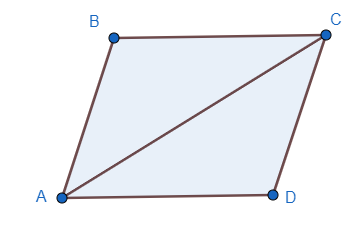
In a quadrilateral ABCD, AB=CD and AD=BC. Prove that ABCD is a parallelogram.
Answer
517.8k+ views
Hint: Start by drawing the diagram, followed by proving that the opposite angles of the quadrilateral ABCD is equal using the properties of congruent triangles. If opposite angles of a quadrilateral are equal, then the quadrilateral is a parallelogram.
Complete step-by-step answer:
Let us start by drawing the diagram for a better visualisation of the situation given in the question.

It is given that AB=CD and BC=AD. Also, we can see that AC is common in
Therefore, by using CPCT, we can say that:
Now if we add equation (i) and equation (ii), we get
Now from the figure, we can deduce that
As the opposite angles of quadrilateral ABCD are equal, i.e.,
Note: It is prescribed to learn all the basic theorems related to congruence and similarity of triangles as they are used quite often. Also, learn the properties of parallelograms, including squares, as they might also be needed for solving such problems as we used in the above question.
Complete step-by-step answer:
Let us start by drawing the diagram for a better visualisation of the situation given in the question.

It is given that AB=CD and BC=AD. Also, we can see that AC is common in
Therefore, by using CPCT, we can say that:
Now if we add equation (i) and equation (ii), we get
Now from the figure, we can deduce that
As the opposite angles of quadrilateral ABCD are equal, i.e.,
Note: It is prescribed to learn all the basic theorems related to congruence and similarity of triangles as they are used quite often. Also, learn the properties of parallelograms, including squares, as they might also be needed for solving such problems as we used in the above question.
Recently Updated Pages
Master Class 9 General Knowledge: Engaging Questions & Answers for Success

Master Class 9 English: Engaging Questions & Answers for Success

Master Class 9 Science: Engaging Questions & Answers for Success

Master Class 9 Social Science: Engaging Questions & Answers for Success

Master Class 9 Maths: Engaging Questions & Answers for Success

Class 9 Question and Answer - Your Ultimate Solutions Guide

Trending doubts
Fill the blanks with the suitable prepositions 1 The class 9 english CBSE

Difference Between Plant Cell and Animal Cell

Given that HCF 306 657 9 find the LCM 306 657 class 9 maths CBSE

The highest mountain peak in India is A Kanchenjunga class 9 social science CBSE

What is the difference between Atleast and Atmost in class 9 maths CBSE

What was the capital of the king Kharavela of Kalinga class 9 social science CBSE




